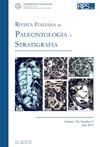EOCENE RHAMPHOSIDAE (TELEOSTEI: SYNGNATHIFORMES) FROM THE BOLCA LAGERSTÄTTE, ITALY
IF 1.9
3区 地球科学
Q2 GEOLOGY
引用次数: 0
Abstract
The Rhamphosidae is an extinct family of syngnathiform fishes from the lower Eocene deposits of Europe, primarily known from specimens derived from the Ypresian Konservat-Lagerstätte of Bolca (Verona province, Italy). A descriptive analysis of 28 specimens of Rhamphosus from Bolca revealed the existence of six species, showing a greater taxonomic diversity compared to the previous scenario of only two species (the type species Rhamphosus rastrum and Rhamphosus biserratus). Four new species are established herein: Rhamphosus bloti n. sp., characterized by a peculiar and unique rostrum with a discoid shape; Rhamphosus brevirostris n. sp., which exhibits a moderately large size associated with a relatively short rostrum; Rhamphosus longispinatus n. sp., characterized by having the longest dorsal-fin spine and rostrum of all the Rhamphosus species; Rhamphosus tubulirostris n. sp., which shows a peculiar slim rostrum, long-based dorsal and anal fins, and a unique squamation characterized by the presence of numerous bucklers. The species from Bolca are also compared to the only other known Rhamphosus species, Rhamphosus rosenkrantzi, from the Fur Formation, Denmark. A number of morphological features support the assignment of the Rhamphosidae to the syngnathiform clade Dactylopteroidei, together with the extant families Dactylopteridae and Pegasidae, representing the sister group to the Pegasidae.来自意大利博尔卡工厂
Rhamphosidae是欧洲始新世晚期沉积物中已灭绝的合颌形鱼类,主要来自Bolca (Verona省,意大利)的Ypresian Konservat-Lagerstätte标本。通过对Bolca地区28份鼠耳草标本的描述性分析,发现该地区存在6种鼠耳草,其分类多样性明显高于之前的模式种Rhamphosus rastrum和Rhamphosus biserratus。本文建立了4个新种:以独特的盘状喙部为特征的鼠爪;Rhamphosus brevirostris n. sp.,显示出中等大小和相对较短的喙;长棘鼠,其特点是在所有鼠属动物中具有最长的背鳍脊柱和喙;管状鼠鳍鱼,有特别细的喙部,长背鳍和肛门鳍,有独特的鳞片,其特征是有许多扣。来自Bolca的物种还与来自丹麦Fur Formation的Rhamphosus rosenkrantzi的唯一已知的鼠耳草物种进行了比较。许多形态学特征支持将鼠足科与现存的Dactylopteridae科和Pegasidae科一起归属于合鸟形分支Dactylopteroidei,代表了Pegasidae的姐妹群。
本文章由计算机程序翻译,如有差异,请以英文原文为准。
求助全文
约1分钟内获得全文
求助全文
来源期刊
CiteScore
3.60
自引率
4.30%
发文量
28
审稿时长
>12 weeks
期刊介绍:
The Rivista Italiana di Paleontologia e Stratigrafia was founded in 1895. It publishes original papers dealing with all fields of paleontology and of stratigraphy, from Italy and the Mediterranean to the Tethys, as well across the globe from China to North America.

 求助内容:
求助内容: 应助结果提醒方式:
应助结果提醒方式:


